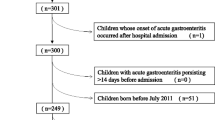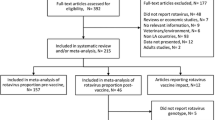Abstract
Rotavirus vaccines have been developed to prevent deaths resulting from severe diarrhea of rotavirus origin. The use of vaccines as an intervention at scale to prevent and control the burden of rotavirus diarrhea is supported by the argument that prevailing public health measures such as hygiene and sanitation, breast feeding and use of ORS have failed to prevent severe dehydration resulting from diarrhea. The article reviews the existing evidence on the rationale of using rotavirus vaccine as against the feasibility of scaling it up in developing countries like India. The vaccines currently available may not cover the strains circulating in Indian population. The diversity of Rotavirus infection in the country is tremendous and since the safety, immunogenicity and efficacy data has not been collected for India, there is first a need to conduct studies to measure the extent of protection and cross-protection provided by the available vaccines for local strains, before venturing into Rotavirus vaccination program. The potential benefits of immunization have to be first vetted against the risks involved by the policymakers and other stakeholders.
Similar content being viewed by others
References
Keusch GT, Fontaine O, Bhargava A, et al. Diarrheal diseases. In: Jamison DT, Breman JG, Measham A, et al., editors. Disease control priorities in developing countries. 2nd ed. New York: Oxford University Press; 2006. p. 371–87.
Parashar UD, Hummelman EG, Bresee JS, Miller MA, Glass RI. Global Illness and Deaths Caused by Rotavirus Disease in Children. Emerg Infect Dis. 2003;9:565–72.
Kang G, Kelkar SD, Chitambar SD, Ray P, Naik T. Epidemiological profile of rotaviral infection in India: challenges for the 21st century. J Infect Dis. 2005;192:S120–6.
Zissis G, Lambert JP, Marbehant P, et al. Protection studies in colostrum derived piglets of a bovine rotavirus vaccine candidate using human rotavirus strains for challenge. J Infect Dis. 1983;148:1061–8.
Penelope HD. Rotavirus vaccines: an overview. Clin Microbiol Rev. 2008;21:198–208.
Block SL, Vesikari T, Goveia MG, et al. Efficacy, immunogenicity and safety of a pentavalent human-bovine (WC3) reassortantrotavirus vaccine at the end of the shelf life. Pediatrics. 2007;119:11–8.
Mendoza AV, Bertozzi SM, Gutierrez JP, Itzler R. Cost effectiveness of introducing a rota virus vaccine in developing countries: the case of Mexico. BMC Infect Dis. 2008;8:103.
Zaidi A, Awasthi S, de Silva HJ. Burden of infectious diseases in South Asia. Br Med J. 2004;328:811–5.
Brown DW, Mathan MM, Mathew M, Martin R, Beards GM, Mathan VI. Rotavirus epidemiology in Vellore, South India: group, subgroup, serotype, and electrophore type. J Clin Microbiol. 1988;26:2410–4.
Ramani S, Kang G. Burden of disease & molecular epidemiology of group A rotavirus infections in India. Indian J Med Res. 2007;125:619–32.
Kang G, Green J, Gallimore CI, Brown DW. Molecular epidemiology of rotaviral infection in South Indian children with acute diarrhea from 1995–1996 to 1998–1999. J Med Virol. 2002;67:101–5.
Cicirello HG, Das BK, Gupta A, et al. High prevalence of rotavirus infection among neonates born at hospitals in Delhi, India: predisposition of newborns for infection with unusual rotavirus. Pediatr Infect Dis J. 1994;13:720–4.
Iturriza GM, Kang G, Mammen A, et al. Characterization of G10P [11] rotaviruses causing acute gastroenteritis in neonates and infants in Vellore, India. J Clin Microbiol. 2004;42:2541–7.
Banerjee I, Ramani S, Primrose B, et al. Comparative study of epidemiology of rotavirus in children from a community-based cohort and a hospital in South India. J Clin Microbiol. 2006;44:2468–74.
WHO Collaborative Study Team. Effect of breastfeeding on infant and child mortality due to infectious diseases in less developed countries: a pooled analysis. Lancet. 2000;355:1104.
Clemens J, Rao M, Ahmed F, et al. Breast feeding and the risk of life threatening rotavirus diarrhea: prevention or postponement? Pediatrics. 1993;92:680–5.
Esrey SA, Feachem RG, Hughes JM. Interventions for the Control of Diarrhoeal Diseases among Young Children: Improving Water Supplies and Excreta Disposal Facilities. Bull World Health Organ. 1985;63:757–72.
Victora CG, Bryce J, Fontaine O, Monasch R. Reducing Deaths from Diarrhoea through Oral Rehydration Therapy. Bull World Health Organ. 2000;78:1246–55.
Rose J, Hawthorn RL, Watts B, Singer ME. Public health impact and cost effectiveness of mass vaccination with live attenuated human rotavirus vaccine (RIX 4414) in India: model based analysis. BMJ. 2009;339:b3653.
Griffiths UK, Clark AD, Mulholland KM. Introduction of rotavirus vaccine- getting it to communities at highest risk of mortality from diarrheal disease in the greatest challenge. BMJ. 2009;339:b3482.
Contributions
S N and H H; Did relevant literature search and drafted the manuscript, K S; Gave his inputs on the policy aspects mentioned in the paper, S Z; Provided overall guidance and approved the final version of the manuscript.
Conflict of Interest
None.
Role of Funding Source
None.
Author information
Authors and Affiliations
Corresponding author
Rights and permissions
About this article
Cite this article
Neogi, S.B., Hasan, H., Sheikh, K. et al. Scope for Rotavirus Vaccination in India: Revisiting the Scientific Evidence. Indian J Pediatr 78, 1251–1255 (2011). https://doi.org/10.1007/s12098-011-0448-3
Received:
Accepted:
Published:
Issue Date:
DOI: https://doi.org/10.1007/s12098-011-0448-3




